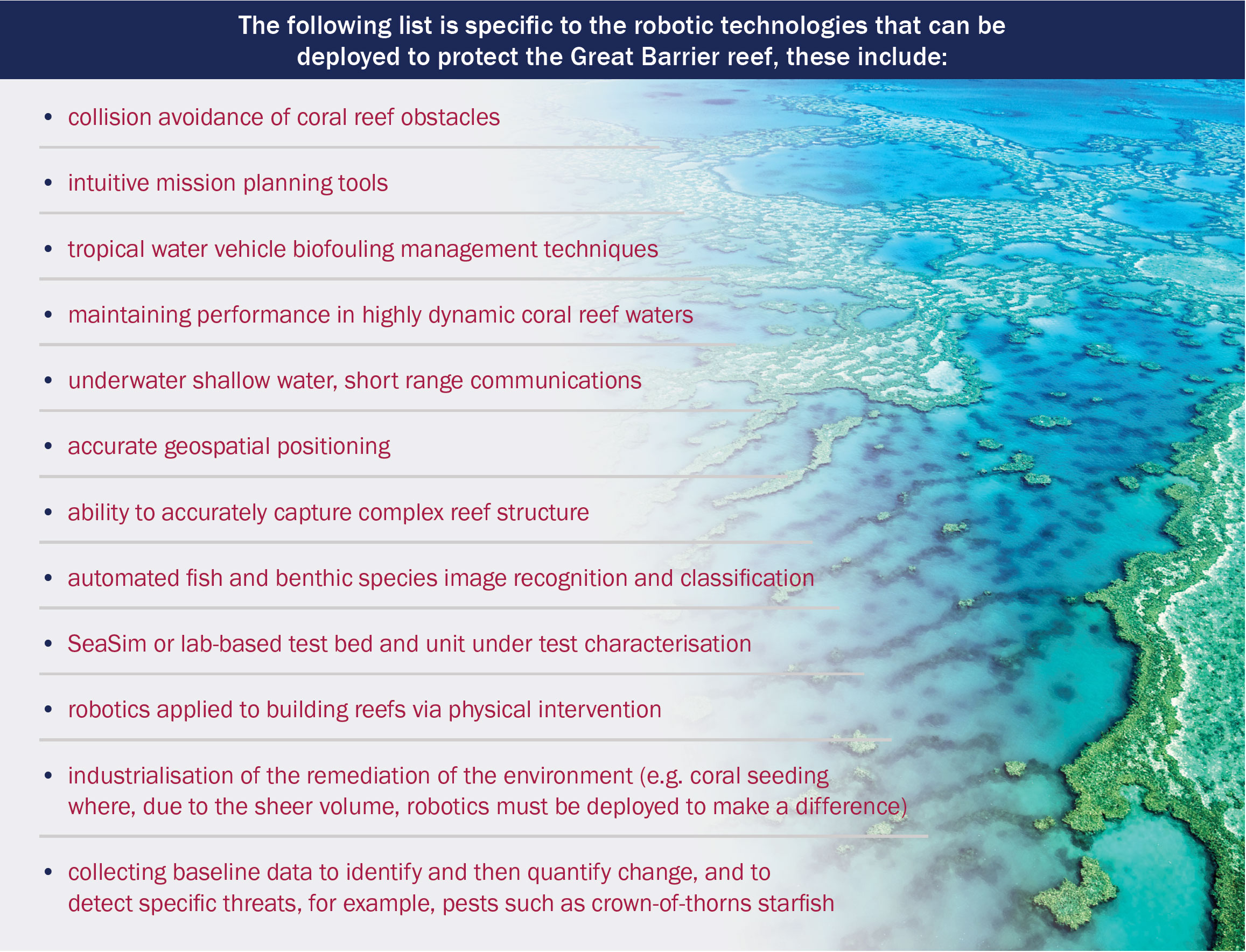
The future of robotics in the environment
Australia has a long and world-leading history of successful deployment of robotics for environmental monitoring and management. There are considerable research and operational examples of environmental robotics in air and sea domains, such as the use of:
- UAVs beyond line of site (BLOS) for the automated detection of Marconia (introduced plant) in the rainforests off Cairns
- UAVs for the detection and automatic classification of koalas for conservation activities
- UAVs for the detection and threat assessment of locus through the Australian outback
- underwater robots and automated classification algorithms for the long-term and repeat monitoring of marine habitats around Australia (see Case Study p. 156)
- underwater robots for the automated detection and injection of Crown-of-Thorns Starfish on the Great Barrier Reef (see Case Study p. 155).
Vision-enabled robots can be deployed in long-duration fleets on land, in the air and in the water, to collect data to be used for exploration, mapping, understanding, stewardship and remediation. While the range of environmental challenges that can be tackled is wide, the type of technologies that need to be deployed are similar across all environments.

Similar lists could be developed and applied to all of Australia’s environmental challenges. Robots performing operations including physical sample and sensor reading collection will greatly benefit from cloud robotics offloading computation to remote resources.
Many of the challenges for use of robots and computers in the environment relate to the sheer distances and persistence required for unsupervised operationalisation across the varied landscapes of the Australian continent. There are a range of technologies that are necessary to help detect, mitigate and solve environmental challenges, many of which may be developed for use in different domains. Such technologies include:
- Autonomous vehicles to access remote tropical marine areas under all weather and traffic conditions. This includes travelling vast distances and operating for months at a time.
- Addition of multifaceted sensor suites aligned with automated data processing workflows (e.g, hyperspectral cameras).
- Overlaid measurements for coral reef health assessments at different altitudes and resolutions, including remote sensing satellite, medium altitude drones and underwater vehicles.
- Ground-based mobile robots that can safely negotiate and operate in remote and rugged terrain without supervision.
- Perception-to-Action activities: real-term interaction with data, where remediation action can be taken as soon as a problem is identified (e.g, detection and extinguishing of a bushfire).
- Long-term (trusted) autonomy – navigation perception capability, long-term planning and robustness (long-term operation without need for repair). Examples include:
- Clearing litter on roadsides where robots need to be able to operate safely near cars and people on rough surfaces while being able to identify a range of objects and take appropriate action (like regulatory and trust issues facing driverless cars).
- Marine monitoring operations where the robot is required to abide by the collision regulations (COLREGs) (like driverless cars on our roads).
- Robust location detection given significant change, e.g, revisiting an area after a natural disaster.
- Robust classification (of plants and animals) in outdoor environments under all weather and lighting conditions with extreme precision (i.e. 100%).
- Systems engineering to ensure robots can survive extreme conditions (fires, floods).
- High speed perception and action, for example, drones operating at low altitudes in forested areas or surface craft negotiating flooded and swift-water environments.
- Improved hardware and algorithms for on-board processing. Due to Australia’s sparse population, many areas do not have internet connectivity and as such, robotic systems in these locations will need to be less reliant on the internet or cloud for perception and classification autonomy.
Workforce Implications
There are many gaps that need to be filled in Australia’s workforce for the full potential of robotic technologies to be realised. These include:
- robotics piloting, maintenance and operations planning training
- programmers to develop bathymetry and oceanographic modelling tools for mission planning
- 24/7 operations teams to support nationwide missions for marine science
- machine learning specialists to tune and generate repeatable information from collected datasets
- image recognition specialists to use static and dynamic traits to classify individual or species level appearance and behaviours
- automated workflow specialists to manage increased data requirements in a scalable fashion
- process and environmental engineering specialists with understanding on how to exploit robotic technology for large-scale land and sea-scape remediation/restoration.
A more robotic/coding-literate community can also contribute to environmental protection and the advancement of science. For this to be successful, the technology must be intuitive and sufficiently advanced to allow auto-classifications and guidance on appropriate remediation activities and then recording and analysis of results. A key opportunity will be in the creation of intuitive user-interfaces for robotic tools to enable citizen science. It is important to engage people with the technology.
Funding sources for these activities is a key challenge for deployment and operationalisation of robotic technologies. Many of these can be applied to the environment and also find application in solving industry-relevant issues. For example, underwater robots for reef management might also be used for underwater asset inspection, land-based fire-fighting robots could be used for forestry or agricultural weeding/fertilising activities. Combined multi-use studies should be considered to facilitate commercialisation of ideas. Upscaling geographic extent and repeat deployments could consider not only commercial operation, but also the training and use by citizen scientists, rangers, schools and community groups. Consideration should be given towards potential research collaborations between environmental robotics researchers and those for defence, infrastructure and agriculture.
